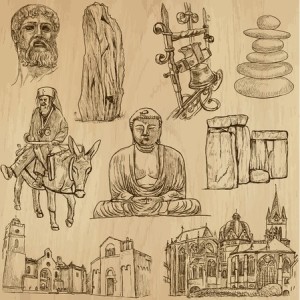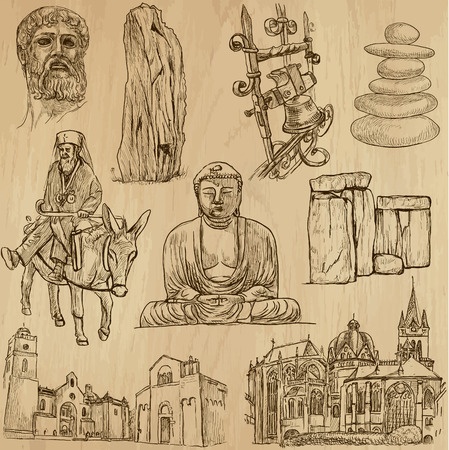
As Terence Gorski has pointed out, A.A. is now legally a “religion” within the US. But I don’t think this really settles the dispute over whether A.A. is or is not religious. Legal rulings can be changed, as they have for many issues such as abortion and marriage. So I’d suggest that A.A. as a “religion” is based upon a particular sense of what “religious” means in modern culture and that could change. There is at least one other view of religion that would not consider A.A. to be religious.
It seems that there two main starting points to define what being “religious” means in modern culture. One follows Edmund Tylor and focuses on the belief in the supernatural, while the other emphasizes Emile Durkheim’s notion of the sacred and the profane. Within American culture, Tylor’s understanding seems to have influenced legal decisions on constitutional issues of the separation of church and state as well as legal rulings on the religiousness of A.A. At this point in time, Tylor’s sense of religion rules the day.
Tylor (1832-1917) simply defined religion as “the belief in spiritual beings” and held that this belief existed in all known cultures. He suggested that a belief in spirits and deities grew out of a belief in souls, which itself was a result of attempting to explain phenomena such as dreams, trances, visions and death. An evolving understanding of religious belief, Tylor’s theory said that all religions were based on animism, which had two parts: belief in a human soul that survived bodily death and belief in other spirits or deities. Animism led to fetishism, the veneration of animals, idols trees and so forth.
This belief was extended to the veneration of spirits and gods which were less attached to objects; leading to the concepts of gods, demons, spirits, devils, ghosts, fairies and angels. The next stage was the association of gods with good and evil, leading to belief in very powerful deities. Another pathway to these powerful gods was to seek after “first causes” for reality. The attribution of good and evil or first cause to the idea of gods and spirits then led to the concept of a Supreme Being. “Animism has its distinct and consistent outcome, and Polytheism its distinct and consistent completion, in the doctrine of a Supreme Deity.”
This seems to have built on the thought of Ludwig Feuerbach, who wrote The Essence of Christianity in 1841. Feuerbach argued against both the divinity of Christ and the existence of God, stating that all theology could be resolved into anthropology—with God as the projected essence of Humanity. What ranked second in religion, namely humanity, must be recognized as first:
If the nature of Man is man’s Highest Being, if to be human is his highest existence, then man’s love for Man must in practice become the first and highest law. Homo homini Deus est— man’s God is Man. This is the highest law of ethics. This is the turning point of history.
Tylor’s ‘evolving’ understanding of religion was similar to that of Carl Jung. Jung saw Western religions as unsophisticated. He said there were five main stages in the evolution of the idea of God.
First was the animistic view, where Nature was ruled by an assortment of gods and demons. Second was the Greco-Roman polytheistic notion of a father of Gods ruling in a strict hierarchy. The third stage idea was that God shared human fate, but was betrayed, died and then resurrected. The fourth stage held that God became Man in the flesh and was identified with the idea of the Supreme Good. Christianity conflated the third and fourth stages, according to Jung.
“The fifth and highest stage of belief in God is when the entire world is understood as a projected psychic structure and the only God is the ‘God within’ or the ‘God-image.’” (Frank McLynn Carl Gustav Jung: A Biography, 409-410) The God-image was a special reflection of the Self, the penultimate archetype of the collective unconscious in Jung’s psychology. This Self was not the ‘self’ of everyday language, which Jung typically referred to as the ‘ego.’ Frank McLynn suggested that Jung’s Self was roughly equivalent to the ‘Atman’ of Buddhism.
On the other hand, Emile Durkheim said in The Elementary Form of the Religious Life, (EFRL) that religion was a product of society and not always supernaturally inspired. So religion should not be defined just in terms of the ideas of divinity or spiritual beings: “Religion is more than the idea of gods or spirits, and consequently cannot be defined exclusively in relation to these latter.” (EFRL, p. 35) As a category, Durkheim said the supernatural only made sense when opposed to a modern scientific explanation for natural phenomena. He pointed out that for most of the world’s peoples, including premodern Europeans, religious phenomena were viewed as perfectly natural. For Durkheim, the division into “sacred” and “profane” was a necessary precondition for religious belief:
All known religious beliefs, whether simple or complex, present one common characteristic: they presuppose a classification of all the things, real and ideal, of which men think, into two classes or opposed groups, generally designated by two distinct terms which are translated well enough by the words profane and sacred. This division of the world into two domains, the one containing all that is sacred, the other all that is profane, is the distinctive trait of religious thought. (EFRL, p. 37)
Durkheim believed that a belief in the supernatural was not necessary or even common among religions. However, the separation of different aspects of life into the two categories of sacred and profane was common. Objects and behaviors seen as sacred were considered to be part of the spiritual or religious realm. Sacred things for Durkheim were not limited to just gods or spirits. Anything and everything could be sacred: rocks, trees, a spring, a piece of wood, a house. Sacred objects were as varied as the diversity of religions. “Sacred things are simply collective ideals that have fixed themselves on material objects.” Profane things were everything else in the world that did not have a religious function or hold a religious meaning.
There was a radical separation between the sacred and profane, so that the two could not approach each and still retain their essence. The sacred was not the profane and the profane was not sacred; they were “more or less incompatible with each other.” (EFRL, p. 40) And yet, they interact with one another and depend upon each other for survival.
Durkheim believed that religious belief was built upon this fundamental distinction. When a number of sacred things were organized within a belief system that can be distinguished from other similar types of systems, “the totality of these beliefs and their corresponding rites constitutes a religion.” (EFRL, p. 41)
There were two essential criteria for religious belief, according to Durkheim. First, there was a division of the entire universe into the sacred and the profane; which embraced all that exists, but which radically excluded each other. Second, religions formed a Church: “In all history, we do not find a single religion without a Church.”
So then Durkheim defined religion as: “a unified system of beliefs and practices relative to sacred things, that is to say, things set apart and forbidden—beliefs and practices which unite into one single moral community called a Church, all those who adhere to them.” (EFRL, p. 47)
The spiritual, religious distinction made by William James and embedded in Twelve Step spirituality, seems to be the most widely accepted sense of generic spirituality in American culture today. It embraces Durkheim’s thought on religion and rejects Tylor’s understanding. It does this by self-consciously refusing to formulate a unified system of beliefs and practices relative to sacred things and also accepts the naturalness of believing in some type of transcendence. The very heart of Twelve Step spirituality is the permissibility of the individual to formulate a personal understanding of their “god.” So what unites members of Twelve Step groups like A.A. is the diversity of religious and spiritual belief permitted—even to the acceptance of the lack of such a belief.
This is the first of three related articles (What Does Religious Mean?, Spiritual not Religious Experience, The God of the Preachers) that will more fully describe some of the influences I believe helped to shape the spiritual, but not religious distinction of 12 Step recovery.
Originally published on May 22, 2015.





